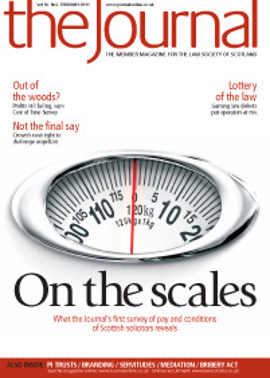Pressure points

The 2010 survey of solicitors’ firms in Scotland is the largest undertaken by any Law Society in the UK, and probably the largest representative survey of law firms in Europe. Based on the results of 220 firms, it indicates an 11% fall in profit per equity partner last year from £72,000 in 2009 to £64,000 in 2010. This follows a 31% fall in 2009 when profits dropped from the 2008 high of £104,000. The picture varies according to size of firm and location, but overall median profit per equity partner has now fallen by over 40% since the recession began, as indicated in Figure 1.
The lower profits in part reflect the ongoing low levels of activity, in particular for property work, but are primarily due to a significant fall in interest received. The average year end of the participants was December 2009, and during 2009 interest rates were very much lower than during 2008, when firms were still earning reasonable amounts of interest.
The chart illustrates the two very different parts to the legal profession in Scotland – the small number of large commercial firms in Edinburgh, Glasgow and the other cities, and the rest of the profession. The chart shows that profits for the larger firms collapsed by nearly 40% in 2009, but bounced back by 30% in 2010. Median profits per partner of £178,000 compare favourably with pre-recession results. They look high relative to the profession as a whole in Scotland, but low when compared to commercial firms south of the border, where profits similarly leapt back in 2010, in particular for the leading City firms.
Interestingly, there was a geographic difference in the results of smaller firms with under 10 partners, with firms in “country” areas, outside the cities, almost maintaining their profits in 2010, as illustrated in Figure 2.
Smaller firms in Aberdeen, Dundee and Perth also appear to have largely maintained profit levels at 2009 levels, as shown in Figure 3 (note – due to the small number of 5-9 partner firms that participated in 2008 and 2009 the medians for those years have been excluded).
Smaller firms in Edinburgh and Glasgow had a more difficult time, with Edinburgh sole principals seeing a 12% fall in profits and their equivalents in Glasgow suffering a 24% drop. Edinburgh 2-4 partner firms saw profits fall by 21%, although similar-sized firms in Glasgow managed to maintain profits at the same level as last year.
So, the position of individual firms has varied, depending on size and location. The situation for most remains fragile as we enter 2011.
Under pressure
2011-12 is going to be a difficult year for most firms:
- the economy remains sluggish, with considerable uncertainty and worries about the impact of public sector cuts;
- in the autumn of 2011 the Legal Services (Scotland) Act will be fully implemented, potentially bringing new competitors into the legal services market and, perhaps more significantly, changing the way existing players operate;
- there will be across-the-board cuts in legal aid – admittedly not as bad as south of the border, but still significant;
- in due course, the recommendations of Lord Gill will be fully implemented.
Some firms have avoided further falls in profitability in 2010, but virtually all are weakened compared to how they were before the recession, have less partner capital and are more dependent on the banks for funding.
If the coming two years could be difficult, it makes considerable sense to start thinking now about how your firm might be affected – while you still have time to respond. How you might respond will depend on your firm’s size and where you are located. As indicated by the survey:
- firms in country areas, and in the smaller cities, appear to have stabilised their profits and adjusted to the reduced volumes of business. Such firms may well be less impacted by ABSs, although they may see lower quality conveyancing work lost to potential new volume operators;
- the large firms appear also to have started to restore profitability, and this is despite continued low volumes of transactions;
- smaller firms in Edinburgh and Glasgow, in particular sole principals, suffered worst. These firms may also be badly impacted by new market entrants, Gill, and the legal aid cuts;
- mid-sized firms in Edinburgh and Glasgow – those with 5-9 partners, who have seen profits fall by nearly 50% since 2008, may also be impacted by the Act and Gill.
Facing up to change
It is interesting to speculate how much the profession might change over the next three to five years – what might it look like by 2015? In rural areas there may still be a large number of small firms, as now. In urban areas and in particular in the cities, we may see far more change. Possibly:
- larger firms as a result of consolidation;
- more specialised firms, in particular in areas such as legal aid;
- greater use of technology in areas that are going to be attacked by new market entrants;
- some interesting joint ventures as some firms take advantage of external investment.
The key is to start planning now, and firms can usefully adopt a 10-stage checklist:
Anticipate your firm’s financial outlook
1. Prepare a fees forecast for the coming year. Also project salaries and overheads and prepare a budget for the coming year – make sure you do not draw more than the projected profit.
2. Prepare a cash forecast – typically for the next three or four months on a weekly basis – so you get a feel for the peaks (caused by income tax and VAT payments, and rent), and are able therefore to speak to the bank in advance if you need to.
3. Consider what financial information could be usefully shared with other fee earners and staff, and might be used to improve performance.
Try to develop a plan
4. Consider your firm’s strengths and its weaknesses. Is it vulnerable or do you see opportunities? What might the implications be?
5. Develop a business plan for your firm, using an external facilitator if appropriate. Try to deal with difficult decisions facing the firm.
6. Consider whether the firm is large enough to face the challenges ahead. One of the results of the relatively long build-up to the Legal Services Act south of the border is that many firms are looking at the possibility of merger – often as a defensive move, but sometimes so as to create a business much better able to respond to the challenges. Merger, in order to better develop teams and make a firm more cost effective, may increasingly be part of the strategy of firms in Scotland.
Improve ongoing management
7. Review how your firm is structured and managed – is the structure right and are the best people managing your firm? Are you making the most of the skills of your partners and other senior staff?
8. Review the financial information the partners look at. Does it highlight the key figures that are central to profitability? Many of these are included in the Cost of Time Survey and a number of the firms that take part benchmark their performance against the figures produced in the survey.
9. Review actual performance against budget every quarter – and update the business and marketing plan.
10. Make sure your partners and other lawyers are getting out and about, as that is when they will stumble on to work opportunities.
Taking Part: the benefits
All participating firms receive a free copy of “The 2010 Survey of Law Firms in Scotland”, the detailed report upon which this article is based. They also receive a free confidential individual report. Other firms can obtain a copy of the full report, which contains a wide range of useful statistics and performance indicators, from the Professional Practice Department at the Society on 0131 476 8164 (mail to: profprac@lawscot.org.uk).
In April, the President will be writing to all firms inviting them to participate in the 2011 survey. Participation is free and carries a three-hour CPD credit as well as an individual report on cost rates in the firm and a copy of the survey report. In recent years there has also been a prize draw. Last year, the £700 prize was won by Saul Kleinglass of Frederick & Co in Glasgow. The Society is again grateful to Alex Quinn and Partners for sponsoring the prize in 2010.
In this issue
- Mutuality in action
- Tough choices
- Show us the files
- RoS launch business eZine
- Rewards of the job
- Pressure points
- Measure for measure
- Rage against the machine?
- Second bite at the cherry
- Personal injury trusts: benefits and PITfalls
- Countdown for Legal Aid Online
- Training: SYLA will play its part
- Law reform update
- Branding or bragging?
- The learning curve
- Ask Ash
- Mediating retirement
- CICA - a question of timing
- The evidence against
- Fought all the way
- Family friendly
- Stakes too high
- Much ado about plenty
- Limits of authority
- Scottish Solicitors' Discipline Tribunal
- Website review
- Book reviews
- Straight dealing
- Servitudes, developers and flexible rights






